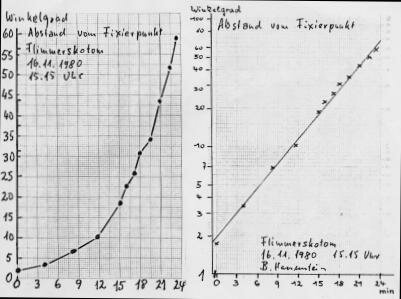





Search | Sitemap | Navigation |  |
|
||||||||||||||||||||||||||
|
||||||||||||||||||||||||||
|
||||||||||||||||||||||||||
|
| Vascular aura pattern |
Aura pattern explained by the neural theory
In the neural theory of migraine aura the migration of symptoms is caused by a system that is far from its thermodynamic equilibrium. A excitation and its migration arise in such systems from local spatial coupling of non-linear dissipative processes. The non-linearity is usually caused by a positive feedback loop of an so-called activator that leads to an "explosion", e.g. highly excited neurons. When the sequence, in which the neurons get excited, is spatially organized by means of intercellular transport, one observes a travelling wave and the medium is said to be excitable. Cortical spreading depression (CSD) is a typical example of such a travelling wave mechanism.

Visualizing the mechanism that leads to propagation in the neural model of migraine aura. The leftmost cell "explodes" and a trigger substance, sometimes called "activator" diffuses towards adjacent cells, where the same reaction is started. © 2005 Markus Dahlem
The important biochemical key elements in travelling waves can be predicted by basic biophysical laws. The intercellular transport via diffusion plays a central role. It is sometimes called "volume transmission" to distinguish it from "synaptic" transmission, which is much faster, or one should rather say, synaptic transmission occurs over much shorter length scales. Thus, slow intercellular diffusion is a speed limiting factor. In fact, the precise wave speed gives a hint about the diffusive activaor, which seems to be a small ion, in the case of CSD.
Hodgkin proposed the first travelling wave model for cortical spreading depression, based on methods introduced by Huxley (both shared a Nobel prize in 1963, together with Sir Eccles, for a similar model of nervous excitation in nerve fibers). The model was unfortunately never published, but communicated to Grafstein (1963) and Bures et al. (1974), as reviewed by Dahlem and Müller (2004). There should be also an internal MIT-note about this model. If you know about this note or even have copy, please let me know.
One of the striking characteristics of a travelling wave is that its speed of propagation is constant. (Yet it may depend on wave front and/or cortex curvature.) Indeed, the velocity of visual migraine aura symptoms is very stable, when measured in cortical coordinates, as shown by Hassenstein (1980) and Grüsser (1995).

Measurement the speed of visual migraine symptoms observed in 1980 by the behavioral biologist Bernhard Hassenstein. © 2005 Markus Dahlem

Lateral views of human brain with different time intervals after start of attack. Adapted from Lauritzen (1987) with permission.
The confined appearance of the symptoms is, however, a central question. If a CSD occures, would it not engulfs all of posterior cortex? Can it be that that only a subset of this activation results in visual awareness. A further discussion of this problem is found in the page devoted to Otto-Joachim Grüsser who addressed the question and gave a first answer.
Author: Markus Dahlem
Last modification of this page: Sunday June 26. 2005
| Vascular aura pattern |
 Top of the page
Top of the page| · | News |
| · | Medical Professionals |
| · | Medical Studies |
| · | Neural vs Vascular Theory |
| · | Otto-Joachim Grüsser |
Copyright © 2005 Migraine Aura Foundation, All rights reserved. Last modification of this site: August 25, 2006
Thanks to: RAFFELT MEDIENDESIGN and GNU software | webmaster@migraine-aura.org
http://migraine-aura.org/EN/Neural_Aura_Pattern.html


